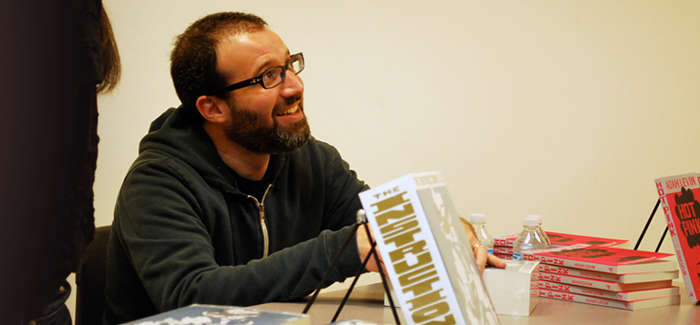
Adam Levin, AM’01. (Photography by Laura Adamczyk)
Adam Levin, AM’01, gives a “hot” reading to a hometown crowd.
“Do you mind if I sit on the table instead of the chair?” Adam Levin, AM’01, asked the small crowd gathered at the Chicago Public Library. It was a sleepy, overcast Saturday in early November at the CPL’s West Town branch; the audience was sedate. Three weeks earlier, Levin had introduced his former Syracuse professor George Saunders at a reading in the Modern Wing of the Art Institute. Like his teacher, Levin has a penchant for combining humor and pathos in his fiction. He crafts stories whose plots keep readers moving forward, while his sentences—with a strong ear for voice—simultaneously ask them to slow down and savor such language. His first book, The Instructions (McSweeney’s, 2010), a 1,000-page tome, follows a ten-year-old boy who, maybe, believes himself to be the messiah.
Levin said this was the first time he was going to read aloud from his story “Jane Tell," which appears in his most recent book, the short story collection Hot Pink (McSweeney’s, 2012). Beneath the fluorescent lights in Conference Room B of the library, he sat cross-legged on the table in front of the room’s white board. He looked almost adolescent in his dark green hoodie and sneakers, calling to mind the story’s 20-year-old drug-dealing, B. F. Skinner–quoting, smart-ass narrator. The story follows the budding relationship of the narrator, Ben, and the titular Jane Tell, who meet in an anger-management class in the Chicago suburbs. Soon after, Ben discovers Tell has an alarming habit: she likes to have strangers beat her up in public. In the Denny’s parking lot after their first date, a random man approaches them and punches Tell in the face. Ben, attempting to come to her defense, swings, misses, and then gets punched himself. “‘Sometimes they like it,’” the man says to him and walks away. Bleeding and bruised, Tell pulls Ben against the wall of the nearby SuperTarget, where they have sex behind a dollar-a-ride carousel. Despite feelings of horror, Ben stays (and has sex) with Tell after two more “Ricks,” her name for such beatings. Ben hates that Jane gets hurt and feels somewhat implicated therein, but he enjoys the outcome, at least in the beginning. If it all sounds a little sensationalistic, consider Skinner’s definition of continuous reinforcement: a schedule of psychological reinforcement in which an action is rewarded every time it occurs.
Levin stopped the story about two-thirds in, then took questions. Does he feel his characters’ emotions? a young man asked. “When something sad happens, I get sad,” he said. “But if something happy happens, I don’t get happy.” Asked if he thought he was a voice for the voiceless, Levin, somewhat incredulously, repeated, “Do I think I’m a voice for the voiceless?” He smiled and shook his head. He said that he considered fiction “deeply selfish work” but that this didn’t bother him. The same man asked if, after the success of The Instructions and Hot Pink, he thought he was coasting on his attractive personality. Though odd, the question was not entirely misplaced. The Instructions earned Levin comparisons to David Foster Wallace and Philip Roth, AM’55, and he happens to be hilarious. He’s self-deprecating and entirely likeable. However, he’s (thankfully) not about to stop writing and “coast” on anything. Levin said that he’s about a year into a new novel and that, through work on The Instructions, he now has a better sense of what roads not to go down in his fiction, that he’s become a better writer on the sentence level. Fielding the audience’s questions, Levin seemed grateful but also amused by the attention. One gets the impression that he finds writing to be a silly way to fill one’s time, though he said it’s the only way he really wants to fill it. Writing, he said, is a “joyful suffering,” and that even though he suffers, “it’s still pretty good.”
